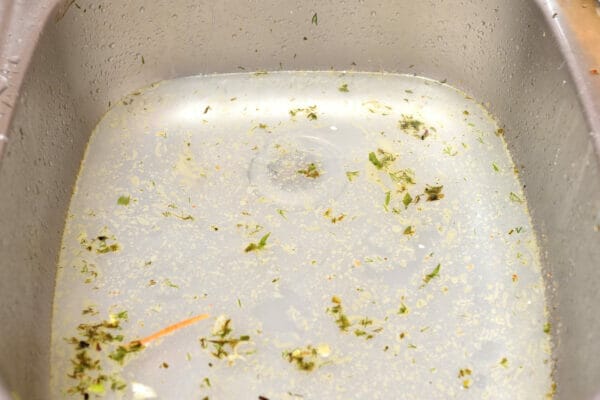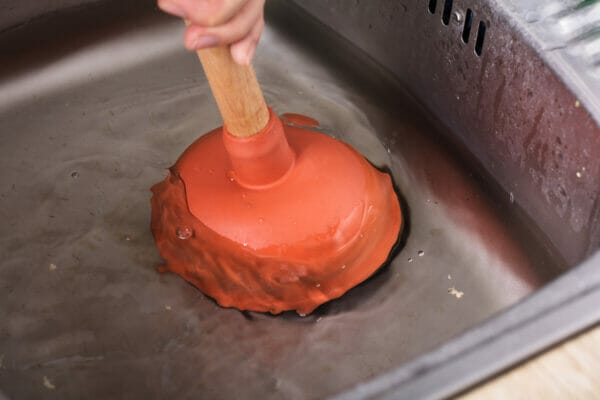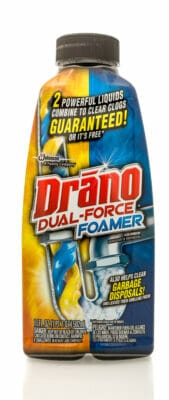Disclaimer: This post may contain affiliate links, meaning we get a small commission if you make a purchase through our links, at no cost to you. For more information, please visit our Disclaimer Page.
According to Fixr, the average cost for repair material and labor to fix blocked garbage disposal is about $300. This amount can increase or decrease depending on the extent of blockage, materials needed, and the plumber’s professionalism.
However, you can learn to do it yourself and save some bucks. So, how do you unclog a garbage disposal drain?
First, ensure that you have all the necessary tools you’ll need in the process, and then switch off the electrical power to the garbage disposal. Inspect the drain to find where the block is, and then use your tools to unblock. If something is blocking it, use a plier to pick it out.

Getting your hands dirty as you unclog the drain is a great way to save time and money. You know t can be quite expensive if you choose to follow other presumably faster ways like using chemicals.
However, the process to do it manually may be unclear to some people, and they end up causing a bigger mess. This article explains a step-by-step guideline you can follow to unclog a garbage disposal drain.
Table of Contents
Why Is My Garbage Disposal Not Draining?
A garbage disposal can clog, and instead of draining the water, you find that the water backs up into the drain or remains still.
If the drain is left unattended, you may notice a foul smell coming from the drain as the garbage begin to decompose in the system.
Normally, garbage disposal easily grinds food remains and then allows them to go through the drain with no problem. However, the problem arises when the ground garbage doesn’t go but instead clogs the drain pipe.
There are many possible reasons why the garbage disposal drain is clogged. Some may be your fault, while others could be caused by the nature of the garbage materials you are disposing of.
For example, if your garbage includes some non-food materials, chances are they will not be ground the same way with other food substances, and so they end up clogging the system.
Some of the reasons why your drain is clogged include:
Insufficient water for flashing
Water is the pushing force for draining garbage. It loosens the food debris, dissolves some of them, and ensures that there is a smooth flow of the garbage through the drainage pipe.
If you use little or no water to flush the garbage, there is a small movement, so the drain gets blocked.
The garbage builds upon the drain line and prevents further movement through the drainage. This could lead to bacteria build-up and a foul smell in your house. To avoid this, you must ensure that you use a lot of water to flush garbage.
This ensures that all of it is gone and does not remain in the drainage pipe.
You can use both cold water and hot water to flush the garbage. Hot water has a higher dissolving power and also kills bacteria along with the drainage system.
Even though you can flush effectively with cold water, it would be good to follow it up with hot water.
Presence of foreign objects in the drain
The garbage disposal drain has a motor that breaks down the garbage so that it can pass through easily without blocking. However, if some foreign materials like silverware or stones get into the garbage drain system, they block the drain instead of passing through.
This is because such objects can not be ground in the motor. Therefore, before channeling the garbage into the drain, it’s important to check it and ensure only soft food materials are in it and not anything hard that doesn’t easily break down.
Uncooperative food waste in the drain
As mentioned earlier, ensure that you only allow food waste into the garage drain. However, there are some foods that end up causing clogs in the drain due to their uncooperative nature.
For example, food waste like banana peels, eggshells, and potato peels form a thick paste after grinding and can easily clog the drain.
If you are disposing of such food waste into the garbage bin, always ensure that you flush it down with a lot of water to avoid clogging.
Water reduces the thickness of the paste and allows it to flow down easily.
Waxy substances in the drain
Ever noticed how fats, oils, and grease repel water? If these substances are put in the garbage disposal drain, they stick and form a waxy substance that repels water.
That means they will not go away with the rest of the waste.
If at all you must dispose of any oily substance in the garbage disposal drain, you must follow it up with hot water to melt it away.
However, the best approach is to ensure you avoid disposing of them through the garbage disposal drain so that they have no chance to clog it.
You can do some things to take care of your garbage disposal system and keep it away from blockages. These include:
- Dispose of soft foods only so that they don’t get stuck in the drainage system. That means you should avoid hard things like bones and seeds in the drainage. Also, avoid banana peels and potato peels that become thick pastes when the ground is on the garbage disposal.
- Ensure that you employ a routine clean-up exercise for your garbage disposal so as to eliminate foul smells. You can do things by pouring some ice and salt occasionally as they effectively get rid of bad bacteria.
- Make sure that you use the garbage disposal drain regularly so that there’s a constant flow of water through it. Activity will clear bacteria build-up and prevent the foul smell from the drainage system.
- Always flush the garbage disposal with a lot of water every time you use it. If you’re flushing fats or greasy substances, you can flow up with hot water to ensure it melts away. Hot water helps to get rid of bacteria too and keep the drainage fresh.
- Use refreshing soaps or detergents to add some freshness to the drainage. You don’t want it smelling foul even after unblocking it.

How Do You Fix A Garbage Disposal That Won’t Drain?
When you notice that your garbage disposal is not draining, it means something is wrong somewhere, and you’ll need to fix it as soon as possible.
Some clogs are small and can be fixed without too much hassle, while others require more effort, like using a plunger or other cleaners to clear them.
Here is a step-by-step guide to fix your garbage disposal brain.
Step 1 – Gather all the necessary tools.
You’ll need a few tools to help you unblock the drain. Some of these tools include pliers, pipe wrench, plunger, Allen wrench, and clamps.
You’ll also need a catch bucket where the stagnant garbage can drain to allow you to fix the clogged area.
You can use other household things like baking soda and white vinegar, which can help get rid of the foul smell already coming out of the clogged area.
They also do a good job of helping to clear the clog in the drain. If the clog is small and does not require so much rigor to remove, you can use some salt solution to do the job.
Step 2 – Turn of the motor’s switch
The motor has a switch where you can turn it on when disposing of the garbage and off after the garbage is drained.
Before you start working on it, you must turn it off and plug it out of the electrical supply. This is a step that will ensure your safety as you handle the motor.
Also, if you leave the motor on as you work on the clog, it might start working and scatter the garbage all over the place. That means you’ll have more work cleaning up the area afterward.
Step 3 – Inspect the garbage disposal to identify where the problem
This is a critical step because you’ll be sure where the problem is, and then you can use the right tools to get rid of it. Some of the problems affecting the garbage disposal include:
- There is a problem with the electrical connection within the wiring unit where power is not getting to the motor, so it doesn’t start. If it doesn’t start, then the garbage remains in the drain and clogs it. In this case, you’ll only need to correct the wiring and start your motor. If it doesn’t run after fixing the wiring, you can bring in a professional to check it.
- The second problem is when the garbage disposal is broken. In this case, the wiring is okay, and the motor is receiving power. However, nothing happens to the waste. A clog could cause this in the flywheel that stops it from rotating properly.
This happens mostly when the food particles or harder substances like silverware hold on to the motor and hinder rotation.
To solve this, you can try turning the wheel manually to jumpstart it. Also, you can pull out any stuck foreign material so that it can rotate with ease.
- The most common problem is the clogs that form in the drain caused by the type of food waste draining in the garbage disposal or other foreign material. The rest of the waste sits on the clog without draining. You’ll need to remove the clog by plunging or manually removing it.
Step 4 – Clean the disposal using a natural cleaner
Natural cleaners are an excellent choice because they are friendly to the good bacteria that decompose the garbage.
This is unlike chemical cleaners that are harsh on the drainage system and the good bacteria. The natural cleaners do a good job of eliminating the bad bacteria and keeping the place clean.
After you have identified the problem and resolved it, you can now cleaner to clean it. The cleaning is important to clear any bacteria to build up that might have taken place when the drain was blocked.
If the clog was because of food waste, you could use vinegar and baking soda mixed in proportions of ¼ a cup and half a cup, respectively.
Pour the mixture into the drain and wait for about 15 minutes for it to work its magic. Follow up by flushing with hot water. This is an effective way to unclog it and do a good cleaning. If this method doesn’t work, you can try manual methods like plunging or manually turning the blade.

Can You Plunge A Garbage Disposal?
Since the most common problem when garbage disposal won’t drain is caused by food waste clogs, most people adopt the method of natural cleaners like vinegar and baking soda to clean it. It works perfectly.
However, there are some cases when you need to put in extra work, especially if the clog is big or the P trap is filled up. You’ll need to use a kitchen sink plunger.
You can follow the following steps to use a plunger properly.
- Check under the sink for a rubber part where you can clamp. It should be on the drain line to the dishwasher. The clamp prevents the foul wastewater from flowing back into the dishwasher and contaminate it.
- Mount the plunger on the top of the sink drain. If there is no water in the sink, you can add some up to about 4 inches. This will ease the drainage after unclogging.
- Plunge in the sink several times until the stubborn clogs disintegrate. Once the drain water starts flowing, you can stop plunging and flush the drain with more water. If you can use hot water, you’ll get better results.
- If the water doesn’t drain after plunging, you may need to disconnect the drainage and clean the strap. Some drainage systems have an S trap, and others have a P trap. Since some debris accumulates here, you can disconnect it and clean it manually. Also, you can use a plumber’s tool called a snake. It goes deep into the sewer line and clears the clogs that didn’t with the plunges.
When unclogging a garbage disposal, be careful not to put your hand into the drain in an attempt to remove the clog with your bare hands. There are different materials that can flow into the drain without your knowledge and can hurt you if you bump into them accidentally.
Some things like silverware that clog the garbage disposal can be dangerous when you try to remove them with your hands.
Therefore, if your choose to remove the clogs that remain stubborn even after plunging and using other cleaners, ensure you use a pair of tongs or something else that can hold the clogging material without harming you.

Can You Use Drano in a Garbage Disposal?
Drano is a chemical-based drainage cleaner that works by initiating a chemical reaction in the clogged drainage.
Drano’s active ingredient is sodium hypochlorite or sodium hydroxide. Some are made from sodium nitrate, sodium chloride, or aluminum.
You can use it to drain your sink, but it will temporarily fix the problem and potentially create a bigger problem. That’s why you must first understand how it works and the danger it might pose in your garbage disposal system.
The Drano’s active ingredient reacts with the organic matter clogged in the drainage and generates high heat to speed up the breakdown of the food waste. Within a few minutes, the clog is clear, and the wastewater flows through fast.
It works the same if the drain is clogged with grease, fats, or oils. That’s because Drano has other chemicals that exhibit soap properties, which is useful in clearing the grease and other oils.
Even though Drano offers a quick solution, it might be dangerous for you and your drainage system. This is because it destroys the plumbing and weakens it over time. The intense heat produced in the reaction and the dissolving of the materials contribute widely to the destroying of the pipes.
The different chemicals used in Drano are too strong and thus cause corrosion on the system over time. Therefore, using Drano constantly can break your garbage disposal drain due to the corroding and dissolving of important proteins.
Other than destroying the drainage system, Drano kills bacteria in the drainage and in the septic tank. The problem is that it kills both the good and the bad bacteria together. The good bacteria is responsible for decomposing the waste in the septic tank and helps to keep it law.
Therefore, when the good bacteria is destroyed, there is a possibility for the septic tank to overflow.
If this happens in your home, you’re likely to incur more charges fixing larger problems and clogs, which you could have prevented if you followed the recommended safer methods of unblocking a clogged garbage disposal drain.
Drano is also not safe for you. That means you must be extra careful when handling it to not touch your skin, eye, or even breathe in its fumes.
Remember that Drano’s primary function is to break down and dissolve the clogging particles so the water can flow easily.
If the Drano gets into contact with any part of your body, the same corrosive action takes place and could end up hurting you if you are not careful. You must wash any area of your body that comes into contact with Drano using a lot of water in order to prevent any reactions.
Because of this dangerous nature, you must be careful how you store it so that children don’t reach it.
There are different methods you can follow to unclog your garbage disposal drain. However, you must consider which one works best for you so that you don’t create a bigger problem for yourself.
